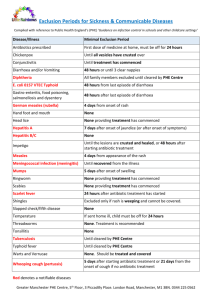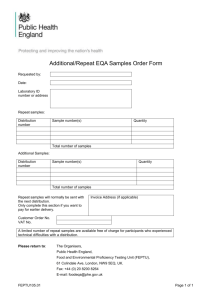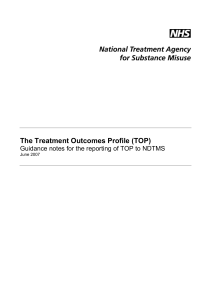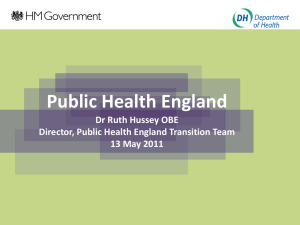Quality and Methodology Information
advertisement
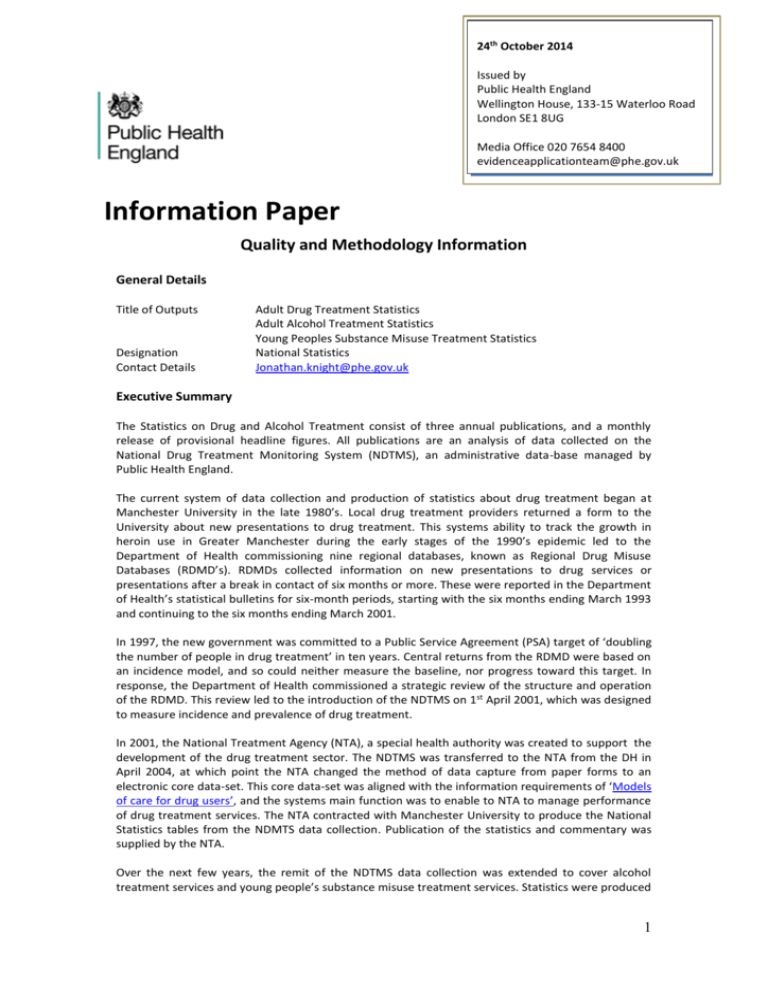
24th October 2014 Issued by Public Health England Wellington House, 133-15 Waterloo Road London SE1 8UG Media Office 020 7654 8400 evidenceapplicationteam@phe.gov.uk Information Paper Quality and Methodology Information General Details Title of Outputs Designation Contact Details Adult Drug Treatment Statistics Adult Alcohol Treatment Statistics Young Peoples Substance Misuse Treatment Statistics National Statistics Jonathan.knight@phe.gov.uk Executive Summary The Statistics on Drug and Alcohol Treatment consist of three annual publications, and a monthly release of provisional headline figures. All publications are an analysis of data collected on the National Drug Treatment Monitoring System (NDTMS), an administrative data-base managed by Public Health England. The current system of data collection and production of statistics about drug treatment began at Manchester University in the late 1980’s. Local drug treatment providers returned a form to the University about new presentations to drug treatment. This systems ability to track the growth in heroin use in Greater Manchester during the early stages of the 1990’s epidemic led to the Department of Health commissioning nine regional databases, known as Regional Drug Misuse Databases (RDMD’s). RDMDs collected information on new presentations to drug services or presentations after a break in contact of six months or more. These were reported in the Department of Health’s statistical bulletins for six-month periods, starting with the six months ending March 1993 and continuing to the six months ending March 2001. In 1997, the new government was committed to a Public Service Agreement (PSA) target of ‘doubling the number of people in drug treatment’ in ten years. Central returns from the RDMD were based on an incidence model, and so could neither measure the baseline, nor progress toward this target. In response, the Department of Health commissioned a strategic review of the structure and operation of the RDMD. This review led to the introduction of the NDTMS on 1st April 2001, which was designed to measure incidence and prevalence of drug treatment. In 2001, the National Treatment Agency (NTA), a special health authority was created to support the development of the drug treatment sector. The NDTMS was transferred to the NTA from the DH in April 2004, at which point the NTA changed the method of data capture from paper forms to an electronic core data-set. This core data-set was aligned with the information requirements of ‘Models of care for drug users’, and the systems main function was to enable to NTA to manage performance of drug treatment services. The NTA contracted with Manchester University to produce the National Statistics tables from the NDMTS data collection. Publication of the statistics and commentary was supplied by the NTA. Over the next few years, the remit of the NDTMS data collection was extended to cover alcohol treatment services and young people’s substance misuse treatment services. Statistics were produced 1 by the NTA for young people’s treatment from 2007/08, and alcohol treatment from 2008/09. Both publications became national statistics in 2012. In April 2013, the NTA was absorbed into Public Health England, and responsibility for the NDTMS and National Statistics was transferred to the new body. All statistics publications, including monthly provisional figures are available from the Manchester University Website. This document contains the following sections Output quality About the output How the output is created Validation and quality assurance Concepts and definitions Other information, relating to quality trade-offs and user needs Sources for further information and advice. Output Quality This document provides a range of information that describes the quality of the data and details any points that should be noted when using the output. The format for this is based on ONS Guidelines for Measuring Statistics Quality, which is based on the European Statistical System (ESS) six dimensions and other important quality characteristics. These are; Relevance Timeliness and Punctuality Comparability and coherence Accuracy Output and quality trade offs Assessment of user needs and perceptions Accessibility and clarity. About the output Relevance The degree to which statistical outputs meet user needs Monthly provisional statistics report key headline figures which enable local commissioners and treatment providers to monitor activity (number of clients treated), and the high level Public Health Framework outcomes (successfully treated, as defined by successful discharge and no re-presentation back to providers within a six month period).The outputs are reported by time series (monthly/annual), clinical areas or “themes” (Opiate and Crack users/Adults, Young People, Alcohol and Mental Health Trusts), region, and local authority area. Outputs are used by Public Health England to monitor progress towards national target of a 1% yearon-year improvement in the proportion of clients successfully treated. At a local level, drug treatment commissioners utilise the data to monitor activity against contracts, and by providers to improve the quality and effectiveness of services. The outputs are used by the Advisory Committee on Resource Allocation (ACRA) as part of the formula to allocate local authority public health budgets. The annual statistics are more detailed, and contain; 2 Alcohol Treatment Key findings: Age and gender of all clients Ethnicity of all clients Source of referral into treatment of new treatment journeys Housing situation of new treatment journeys Waiting times: first and subsequent interventions Treatment interventions and sub-interventions Treatment exits and successful completion Trends in data for structured alcohol treatment in England since 2008-09: Total number in treatment Age and gender of new treatment journeys Waiting times Interventions received Treatment exit reasons Drug Treatment Characteristics of clients: Age and gender of all clients Ethnicity of all clients Primary drug use Source of referral into treatment (new presentations) Age and primary substance (new presentations) Injecting behaviour (new presentations) Housing situation (new presentations) Access to services: Waiting times (first and subsequent interventions) Treatment interventions and sub-interventions Engagement Treatment and recovery outcomes: Treatment exits Treatment Outcomes Profile (TOP) Trends over time: Trends in age group and primary drug group Trends in club drug use Trends in treatment exit reasons Trends in numbers in treatment and numbers retained for at least 12 weeks or completing treatment earlier Trends in waiting times for first intervention A longitudinal treatment population analysis 3 Young people’s substance misuse treatment Characteristics of clients: Age and gender Ethnicity of all clients Substance use Age and substance use Education and employment status Accommodation status Referral source Multiple vulnerabilities Access to services: Waiting times (first and subsequent interventions) Intervention pathways Interventions provided Length of latest episode of specialist interventions Specialist substance misuse service exits: Specialist service exits Discharge destination of ‘complete’ exits Trends over time: Trends in age Trends in primary substance Trends in club drug use Trends in service exit reasons Timeliness and Punctuality Timeliness refers to the lapse of time between publication and the period to which the data refer. Punctuality refers to the gap between planned and actual publication dates. Monthly Summary Information The following summary information is published on (or on the next working day closest to) the 1st of the month, together with the change in total from the previous monthly provisional figure o o o o o o Total number of clients that have been treated in the preceding 12 months, Number in ‘effective treatment’ Number of clients who have started treatment in the past year, and who were either successfully discharged or retained in treatment after 12 weeks Number of opiate clients who have started treatment in the past year, and who were either successfully discharged or retained in treatment after 12 weeks The number of Young People (<18 years) who received treatment in the previous month, and the number who started treatment in the month. The number of people who received alcohol treatment in the previous month. Known issues with the data collection process that affect the figures are also provided. These are primarily a list of providers who failed to submit data to the collection in the month. Figures are provided at national, regional and local authority level. 4 More detailed annual statistics are released in between October and December each year and reports on a number of regular data items recorded by the National Drug Treatment Monitoring System. There are three reports over this period, for the three thematic areas (Adult Drug Treatment, Adult Alcohol treatment, Young Peoples Substance Misuse). For more details on related releases, the UK National Statistics Publication Hub is available online, and provides 12 months’ advance notice of release dates. In the unlikely event of a change to the preannounced release schedule, public attention will be drawn to the change and the reasons of the change will be fully explained, as set out in the Code of Practice for Official Statistics. How the Output is Created. Figure 1 is a data-flow diagram of the production cycle for the statistics. The process, roles and responsibilities for this data-flow are described below. Fig 1 1, 2 - The local treatment record is entered onto a treatment provider’s clinical information system. This is done either using a PHE developed software package (the Data Entry Tool (DET)) or through a commercial product, configured to record and submit against the NDTMS data-standard. Around 86% of the data submitted to the NDTMS is collected on 25 commercial products, and 14% is collected on the DET). 3. At the end of the monthly reporting period, treatment providers extract files from their clinical information systems, and submit these to the Drug and Alcohol Monitoring System (DAMS). Submissions are checked for data quality by regional NDTMS teams, and then approved for upload into DAMS. 4. Data submissions are aggregated and reconciled against previous submissions. A national extract file is provided to both internal PHE analysts and to Manchester University. This is used by both bodies to produce provisional statistics and routine management reporting. 5. Once both the analysts and Manchester University and PHE agree on the statistics these are approved by PHE for release. On the scheduled release the monthly provisional National Statistics are posted on to the Manchester University managed ndtms.net site. Management reports are made available through both ndtms.net and DAMS. Publically released figures have small numbers suppressed, but groups with a professional need for unsuppressed figures (e.g. providers, commissioners) are able to obtain these after logging on. 5 Monthly provisional statistics will commonly be incomplete, as not all 1500 submitting providers will submit each month. There are also likely to be outstanding data quality issues which providers will not have been able to address before the provisional statistics release date. Annual National Statistics releases require that that any incomplete submissions are resolved prior to release. National Statistics are released by financial year, and the submission period for completing submissions extends until the end of July for a previous financial year. Once this has been completed, the data-set for the previous financial year is ‘frozen’, and a copy of the data is then held by both Manchester University and PHE. The National Statistics tables are produced by Manchester University, and verified by PHE. The text within the Annual Statistics reports is produced by PHE. 6. Any data issues with submission files that require flows of patient data between PHE and the treatment providers are managed through the Secure File Exchange. This is a securely encrypted drop-box tool that ensures that information remains confidential during these exchanges. Validation and Quality Assurance Accuracy The degree of closeness between an estimate and the true value 1. Treatment provider data systems and extract. Clinical information systems are provided with a comprehensive, ISB approved standard to ensure that there is consistency and comparability between data returns. The key documents are; a. b. c. d. e. A technical definition (for system developers) A business definition (for clinicians, commissioners etc) A file interface specification with NDTMS systems Reference data (code sets) Other guidance. A full set of documents can be found at http://www.nta.nhs.uk/core-data-set.aspx In order to assist suppliers to produce systems that can interface without errors with NDTMS systems, around 3500 validations that we apply to data published. These are divided into errors and warnings, and information messages. Suppliers are supported by PHE to incorporate these verification rules into their systems (2-4 supplier workshops per year), and provide a test system for them to test extracts against central systems. 2. Data Entry Tool The data entry tool is a simple clinical system that is made available free of charge to treatment providers that submit to the NDTMS. This system is developed and maintained alongside the Drug and Alcohol Monitoring System. We can therefore ensure that all data collected from these providers will meet all of the validation rules prior to submission. 3. Drug and Alcohol Monitoring System (DAMS) a. Data validations The process for submission to the NDTMS requires that a local system extract is taken by the clinical provider from the local system, and submitted to our data warehousing application. Once the file is received, it is processed for internal consistency errors and 6 inconsistencies between the current and previous submission. On average, providers test the validations on DAMS against submission files about three times each month. Data validations are assigned three levels Fatals – Errors in key fields that prevent a file being accepted (e.g. file name error, incorrect field headers.) Warning – Errors that will affect data quality scores, but which can still be accepted into the data-base (e.g. dates out of sequence) Info – Data that looks potentially incorrect 4. Regional monthly handover checks Each month, the regional NDTMS teams complete a handover sheet which indicates any known reasons for fluctuations in the monthly data. This information includes a. b. c. d. e. 5. Handover to PHE analysis team data quality checks a. b. 6. Any missing submissions and reasons Monthly data quality score for region (number of SUBMITTED rows with errors/total number of submitted rows)*100 and reasons why this may be less than 100% Provider closures (current month and upcoming) and new agencies reporting in the month Alerts (number of individuals under 13 being treated for class A drugs, nad number of <18 being prescribed to) Comments. The systems team run a sanity check on the data by calculating the number of records and the monthly change in the data. The PHE analysis team produces high level summary information by provider and local authority area, and look for unexplained monthly variations. Any issues are reported back to the NDTMS team for further investigation. Handover to Manchester University data quality checks Before handing data over to Manchester University, the following internal checks are applied to the data by the analysis team in PHE; Import the files into our chosen data management software (SPSS) and check the record count for each table accurately matches the record count given to us by your team Run our standard code on this, which removes any records which do not comply with certain data rules / policy drivers (for instance removing those resident outside of England. Look at the number of over 18s in ‘effective treatment’* in the latest 12 months that can be reported on If there has been more than 5% movement in any Higher Tier Local Authority Area we email the development team to inform them on these changes The development team then checks with regional NDTMS teams who, in turn, check with local partnerships / providers to ensure this movement is down to genuine activity in the area and is not a data issue Once confirmations have come back from regional NDTMS teams that this is actual data, the extract is signed off 7 7. QA Process for statistics release. Manchester University : Once the data is received by Manchester University, two independent SPSS macros are run to convert the raw data file form a .csv to a .sav file. The scripts themselves take no input and generate no temporary files. No user intervention is required to run these macros. Following this, two further SPSS macros are run to execute exclusions on the data. These take out cases with erroneous ages or date orders and restrict the data to cases with a primary drug (rather than alcohol) and structured treatment modalities. No user intervention is required to execute these macros. The resulting post exclusion files are then subjected to a third pair of SPSS macros which calculate journey numbers for each case. All episodes of data for a DAT/attributer combination are aligned chronologically and labeled with the same treatment journey until there is a gap of more than 21 days between an episode discharge and any other modality start date. New episodes that start after such a gap will be labeled as a subsequent episode. This process continues throughout the data until all cases are labeled with a journey number. The resulting files are then available for use for production of the annual report and feed separately into the double verification process outlined below. All macros are verified and signed off by PHE prior to regular use. PHE: The process is similar to that described above, and requires five processes (each stage is marked in bold). Upon receipt of data, syntax is run in SPSS to convert the .csv to a .sav file by a process requiring no intervention from the analyst running this (1). Basic exclusions are carried out in a second syntactical process, which again requires no alteration from the analyst (2). Following this, treatment journeys are allocated to the month’s data by a third piece of syntax according to the rules stated above (a new journey commencing when a modality starts more than 21 days after all previous episodes have been discharged) (3). This file is referred to as the Master journey file. It is required that one date is altered each month in this syntax in order to exclude episodes starting after the end of the month of the data extract. The single intervention required by the analyst running this is clearly highlighted at the top of the syntax file. Once the figures are produced, these are checked against those produced by Manchester University. Any discrepancies are investigated and resolved with them until both parties are satisfied that the figures match (4). The final report is produced and all figures are checked against the verified final results (5) The final report is also proof read by the PHE Drug and Alcohol Policy Team and DH Policy colleagues to ensure that the commentary regarding drug and alcohol policy are correct and that the data has been interpreted correctly. 8. Data and data quality returns to providers and commissioners. A data quality report is sent to each provider each month. Individual records may be returned to the providers where there are issues or queries that need to be resolved. All providers are able to access an full extract of all of the their NDTMS data on request. Coherence and comparability Coherence is the degree to which data, that are derived from different sources or methods but refer to the same topic, are similar. Comparability is the degree to which data can be compared over time and domain for example, geographic level. The data used in the annual report comes from an extract from the Drug and Alcohol Monitoring System (DAMS), which covers the period up to 30th June of the relevant year, and is provided to the 8 Analysis Team and Manchester University in late July. Prior to the receipt of the final extract the Analysis Team at PHE will investigate provisional data (the effective treatment indicators cannot be investigated as these require a delay in reporting of three months). This three month period is used to ensure that all treatment providers annual submissions for the previous financial year are as complete as possible. At this point in the cycle, the data for the previous year is ‘frozen’, and this data is used for all future reporting of statistics. However, the NDTMS is an operational system, and subsequent revisions to the submissions can contain corrections of previous records. The volume of these is small, and these are unlikely to have a meaningful impact on published statistics. It should be noted that young people’s figures are not comparable with statistics relating to adult drug or alcohol treatment. This is because the UK guidelines for Drug Misuse and Dependence recommend that access to specialist services for young people requires a ‘lower severity of drug use and associated problems’ (p85). Wherever possible, PHE endeavors to ensure that analysis of key statistics are undertaken and presented in a consistent manner, to enable comparisons between current and previous publications. Where this is not possible, changes are clearly explained within the relevant publication to allow the user to take this into account when making comparisons. International Comparability The Welsh government publishes substance misuse statistics, which include treatment statistics from the Welsh National Database for Substance Misuse, as well as other information available from other routine data sources. The most recent statistics can be found here: Statistics about drug misuse in Scotland are published by Drug Misuse Information Scotland and can be found here: Statistics about drug misuse treatment in Northern Ireland are published by DH, Social Services and Public Safety of the Northern Ireland Executive. The most recent of these can be found here: The European Monitoring Centre for Drugs and Drug Addiction (EMCDDA) publish an annual report that describes and compares aspects of drug use and drug policy within European states, as well as providing detailed comparative statistics. This can be found here: The centre also produces a Treatment Demand Indicator (TDI), which is a collection of comparative statistics relating to individuals seeking treatment. This can be found here: The United Kingdom (UK) Focal Point on Drugs is the national partner of the European Monitoring Centre for Drugs and Drug Addiction (EMCDDA) and provides comprehensive information to the Centre on the drug situation in England, Northern Ireland, Scotland and Wales. The UK Focal Point on Drugs is now part of PHE. The Focal Point works closely with the Home Office, other government departments and the devolved administrations. In addition to contributing to the EMCDDA annual report, it collates an extensive range of data in the form of standard tables and responses to structured questionnaires, which are submitted regularly to the EMCDDA. It also contributes to other elements of the EMCDDA’s work such as the development and implementation of its five key epidemiological indicators, the Exchange on Drug Demand Reduction Action (EDDRA) and the implementation of the Council Decision on New Psychoactive Substances. The most recent report can be found here. NDTMS figures for England are collated by NDEC with those for Scotland, Wales and Northern Ireland, into a UK return for use by EMCDDA and for the United Nations. NDEC is part of the Health Sciences Research Group in the School of Medicine, University of Manchester. Concepts and Definitions. 9 The data on which these streams of statistics are based is collected by the National Drug Treatment Monitoring System (NDTMS). This is an administrative data source that is managed by Public Health England, and is primarily used to produce statistics for the Public Health Outcomes Framework, monitor service quality and delivery, and to inform commissioning. The NDTMS maintains a detailed set of documentation that describes the data-set collected, with detailed guidance for clinicians and software providers. These can be accessed here. Other information Output quality trade-offs Trade-offs are the extent to which different dimensions of quality are balanced against each other. In order to link individual’s treatment records at multiple treatment providers, the NDTMS collects and uses initials, date of birth and gender. At a national level, the error rate in matching on these identifiers is around 3%, although this falls to under 0.5% for local authority level matching. The NDTMS collects highly sensitive personal data with the individuals consent, and so there is a trade-off between being able to match more accurately, and an increased rate of consent refusals as a result of requesting more easily identifiable data (e.g. full name) to be collected. The NDTMS consent refusal rate under 1%, and the current system is thought to offer the best trade off in terms of overall accuracy and completeness of the statistics. User Needs and Perceptions. The processes for finding out about uses and users, and their views on the statistical products. In 2009 the NTA undertook a consultation relating to changing the recording of treatment types on the NDTMS to better reflect clinical practice and guidelines. These changes were implemented in 2010. In 2011 the NTA undertook a consultation into changing the way in which treatment settings and intensity are recorded, and introducing new data for recording recovery (post treatment) support for clients. A second consultation in 2011 into changes in the reporting of the way the length of time clients spend in treatment, treatment completions, representations and outcomes within the national statistics was undertaken. Responses to this are available here. In 2012 the NTA managed a consultation regarding the introduction of an outcome monitoring tool for alcohol treatment services. Responses to this consultation are available here. In 2012 the NTA also managed a consultation to amend the young people’s data-set to capture more risk factors and outcomes for young people, update specialist interventions, settings and definitions. The consultation also addressed how information relating to Hepatitis B and C information is captured, and to remove items from the data that are not applicable to young people. Responses to this consultation are available here. In 2013, PHE undertook a consultation into introducing a new reporting methodology relating to drug and alcohol treatment services Useful Links Prevalence of drug use An annual estimate of the prevalence of drug use is undertaken through the Crime Survey for England and Wales (CSEW, formerly the British Crime Survey (BCS)). This section of the survey has been in place since 1996, annually since 2001, and has tracked the prevalence of the use of different drugs over this time. 10 A second method for estimating the prevalence of crack cocaine and heroin use is produced for each local authority area in England by Glasgow University. Estimates are available for 2006-07, 2008-09, 2009-10 and 2010-11. The estimates are produced through a mixture of capture-recapture and Multiple Indicator Methodology (MIM), and rely on NDTMS data being matched against and/or analysed alongside Probation and Home Office data sets. The data and further information are available here: Young people Information is also available relating to the prevalence of drug use among secondary school pupils aged 11 to 15 from the Smoking, Drinking and Drug Use Survey among young people in England. This is a survey carried out for the NHS Information Centre by the National Centre for Social Research and the National Foundation for Educational Research. The survey annually interviews school pupils, and has been in place since 2001. The data and further information are available here; Criminal Justice statistics The Ministry of Justice produces a quarterly statistics bulletin which provides details of individuals in custody and under the supervision of the probation service. These can be found here: Statistics are also produced by the Ministry of Justice relating to aspects of sentencing, including trends in custody, sentences, fines and other disposals. These can be found here: Drug related deaths The Office for National Statistics publish an annual summary of all deaths related to drug poisoning (involving both legal and illegal drugs) and drug misuse (involving illegal drugs) in England and Wales. This can be found here: . Relevant web links Monthly web-based NDTMS analyses http://www.ndtms.net/ National Drug Evidence Centre (NDEC) http://www.medicine.manchester.ac.uk/healthmethodology/research/ndec/ Public Health England http://www.gov.uk/government/organisations/public-health-england 11
